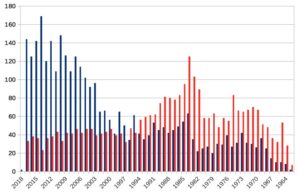Antibiotic Pollution Index: 203 (19 November 2017)
What is the Antibiotic Pollution Index?
What it does
Clarithromycin inhibits the synthesis of proteins in many different types of bacterial pathogens. It does so in some parasites as well, such the one responsible for toxoplasmosis.
Who gets it
Clarithromycin is used to treat lung, stomach and throat infections, and other infections of the gastrointestinal tract, respiratory tract, or skin. In case of pregnancy, this drug should be taken only when absolutely necessary, as it slightly increases the risk for a miscarriage. When it entered the market, its efficacy against Mycobacterium Avium Complex (MAC), a lethal lung infection in patients with a defect immune system, had a great impact among carriers of HIV – not the least because the industry delayed market entrance in the US for economic reasons. It is a popular drug: it is highly consumed, for instance, in Canada it ranked second after amoxicillin in 2014. Resistance level are, however, fairly high as well. In Asia, resistance levels in S.pneumonia reached 80% in the beginning of this century. In Canada, 22% was resistant in 2014, the highest rate of all antibiotics in this pathogen. Worldwide, it may be used in food animals, but clarithromycin’s ancestor, tetracycline, is more abundantly used. There seems nevertheless a noticeable interest of pet-owners to purchase this drug on-line.
Where may it be produced?
India, Japan, USA, Saudi Arabia, Spain, Mexico, China, Germany, Malaysia, Israel.
And, SquaredAnt, does it pollute?
There is evidence for trace amounts in the environment in Germany, the UK, and Canada; in Spain, the concentration tends to be substantial, up to 1 ng/ml in hospital waste water and o.5 ng/ml in Waste Water Treatment effluents. Such values are well above the predicted concentration that leads to resistance, which is 0.25 ng/ml.
Warning lights
Anno 2017, a clear warning light comes from the Helicobacter pylori community, that has to deal with a bacterium that infects half of the worlds population, causes ulcers in 10% of these carriers and is strongly linked to cancer in the stomach (1-3% of people infected develop stomach cancer, a disease that causes 700.000 deaths per year worldwide). Whereas billions of people are only carriers, the infection can become symptomatic with grave consequences when left untreated. H.pylori infections are often treated with a cocktail of drugs, and clarithromycin is usually among these. Despite a sharp increase in resistance rates in H.pylori (from 5% to 50% from 1993 to 2013), there is no alternative for clarithromycin in the drug cocktail. This leads to desperation, as reflected by the following quote: “The problem with this critical role [of Clarithromycin] is that antimicrobial resistance to this drug is sharply increasing and our hopes to have successful eradication regimens (i.e., consistent treatment success > 90%) including the clarithromycin is unfortunately falling.”
Any common sense in this antibiotic?
Clarithromycin is an essential drug according to the WHO and indispensable for H.pylori treatment. Furthermore, this drug is popular and used for many other infections too, for human disease and in animals as well. Resistance against this drug is increasing. Once resistance occurs to clarithromycin, resistance to other important antibiotics such as erythromycin occurs as well, and vice versa. More restricted use of clarithromycin and its related drugs, especially in the veterinarian domain, could safeguard its efficacy in human disease.
Sources
- Production locations
- Helicobacter pylori as high priority pathogen by World Health Organization
- H.Pylori antibiotic resistance
- Ulcers and H.pylori
- H.pylori: stomach disease and other consequences
- About H.pylori infections and stomach cancer
- Predicted concentrations that select for antibiotic resistance
- Canadian statistics on antibiotic use and resistance
- Pet community’s interest in on-line drug purchasing
- Clarithromycin’s delayed US market entrance
- Clarithromycin and the risk for a miscarriage


